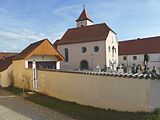Hohentreswitz Castle
The listed Hohentreswitz Castle is located in the eponymous district of the Upper Palatinate town of Pfreimd in the Schwandorf district of Bavaria ( Hohentreswitz 106).
history
The first definitely documented owner of Hohentreswitz ( Deswitz auf der Höch ) is Ott Planckenfellser , named on March 15, 1464 , who, together with Hyltpolt Steiner and Jorg Planckenfellser zu Swertzenfeld, attests to a deposit redemption . A Caspar von Plankenfels to Hohentreswitz is 1,498 to 1,501 judges and Kastner to Nabburg . Cristoffer von Blankenfels zu Dreswitz auf der Höhe sells on Pfintztag According to Martini 1505 with the consent of his wife Ursula an annual valid from two of his courts in Sitzambuch and Hohentreswitz. From 1518 to 1546 the Otten von Plankenfels is mentioned on the allodial estate ; the estate is referred to as the noblemen's seat and the Hofmark , with jurisdiction over the neck of the Nabburg court.
After Ott von Plankenfels died in 1546 without an heir, Wolff von Weyhern zu Heinersreuth , the husband of a niece of the deceased, registered inheritance claims, which he was granted. This owner apparently died soon and so his heirs are named as holders of the court rights in 1550 and 1563 at the Landtag in Amberg . In 1576 the country estate passed to Veit Hans von Prandt († 1578), acting country marshal. Since this family had already acquired stone and ponds at the beginning of the 16th century , this family was one of the wealthiest in the district. In 1578 his son of the same name, Veit Hans von Prandt, succeeded him to Stain vnt Reswitz on the Höch . In 1599 Friedrich Unruh took over this manor. He was followed in 1609 by his stepson Wolf Heinrich von Trautenberg , who acquired Hohentreswitz on Gantweg . Because of the resignation of the compulsory Landsassen there were problems with him, because he was undecided to convert to the Catholic faith. This dispute dragged on until 1629, as the Trautenberger was difficult to reach due to frequent changes of his whereabouts. Trautenberg's wife turned out to be unwilling to convert. In 1629 she and Konrad Teufel von Schwarzenfeld asked in a petition to remain on her property despite her belief. Apparently, an order from the government brought about a change, because after 1630 nothing more is heard of this matter. Hochtrswitz remained with the Trautenberg heirs during the Thirty Years' War until 1651. The only surviving fiefdom lapel of the Hohentreswitz tithe , which was awarded to Georg Sauerzapf at the end of the 14th century according to the Leuchtenberig book of fiefs, dates from November 7, 1644 . Now, 250 years later, belehnte Landgraf Maximilian the Adam Hans Christoph Bernclau of Schoenberg Reuth and Georg Christoph Muenzer of Kümmersbruck as guardians of the two of Wolf Heinrich von Trautenberg posthumous minor ennen sons, Erdmann and Georg Friedrich with the tithe to Treßwitz vf height large and small , dead and living .
In 1651 Bartholomäus Göring acquired the aristocratic estate on Kaufweg and paid hereditary homage a year later. After his death, he died on August 16, 1682, according to the Landsassenmatrikel of 1694 and 1696 Johann Georg Göring followed him . But Servatii von Hartenstein , former Vice Chancellor von Amberg, is mentioned here as early as 1709 . In 1715 a Michael Sebatisn Boslarn seems to have bought Hohentreswitz. This Boslarn was able to expand his property by acquiring subjects to ponds. After his death († around 1740) the owners of Hohentreswitz changed relatively quickly. Mention should be made of Joachim Joseph Fick (1744 and 1747), Sulzbachischer Rat, Sigmund Friedrich von Stetting (1752), pastor of Oberviechtach , Freiherr von Morawitzky (1772) and then the licentiate Wittmann (1780), district judge of Waldthurn . A few months later, Wittmann had to hand over the manor to the sergeant-major of the two-bridge infantry regiment, Moritz von Stetting . Until his death he was in a dispute with the court chamber in Munich, because he did not want to pay the Landsassen contribution and was also seeking an exemption from unpaid income . His widow, Josepha von Stetting , then faced the same demands. In 1802 she sold the country estate to Joseph Schrott and was able to use the proceeds to settle the debts on Hohentreswitz and thus end the 20 year dispute.
Joseph Schrott remained in the possession of Hohentreswitz until January 1804, when he sold the estate to Joseph Freiherrn von Karg , the owner of Trausnitz im Tal . The jurisdiction belonging to the estate was withdrawn in 1808. After his death, his widow, Elisabeth von Karg , tried to regain these rights. In 1818 jurisdiction was returned to them, but the establishment of a second class patrimonial court was denied. In 1827 the jurisdiction was finally withdrawn. An allodification of the former Leuchtenberg knightly tithing took place on January 21, 1824. Hohentreswitz remained an independent municipality until May 1, 1978 and was then incorporated into Pfreimd.
Hohentreswitz Castle today
The castle is next to the church and the cemetery of Hohentreswitz. The former castle church of St. Bartholomew is slightly inclined compared to the castle building.
The former Hofmarkschloss is now used as an inn (Gastwirtschaft Edi Maier). It is a hipped roof building , the core of which dates from the 17th century. On the east side there is a baroque portal with the figure of St. George from the 18th century.
literature
- Elisabeth Müller-Luckner: Nabburg (pp. 190–197). (= Historical Atlas of Bavaria, part of Altbayern booklet 50). Commission for Bavarian State History, Verlag Michael Lassleben, Munich 1981, ISBN 3-7696-9915-7 .
Web links
- Entry on Hofmarkschloss Hohentreswitz in the private database "Alle Burgen".
- Aerial photos of Hohentreswitz
- 19th century local papers, Hohentreswitz (1836)
Coordinates: 49 ° 29 ′ 49.2 " N , 12 ° 15 ′ 23.8" E




